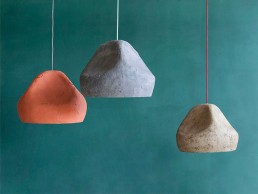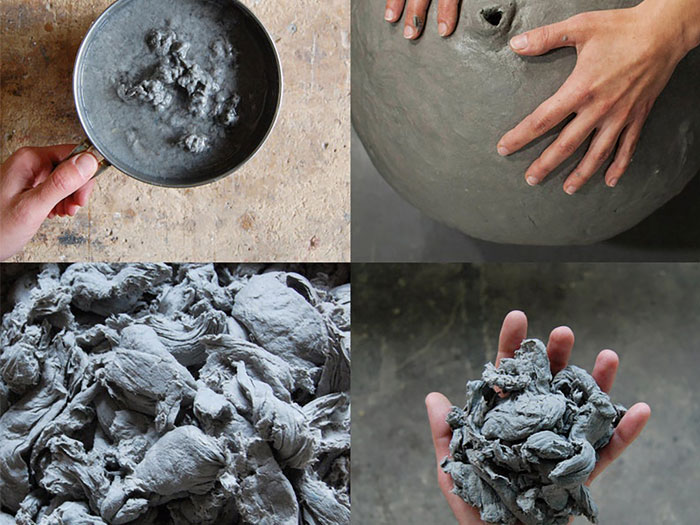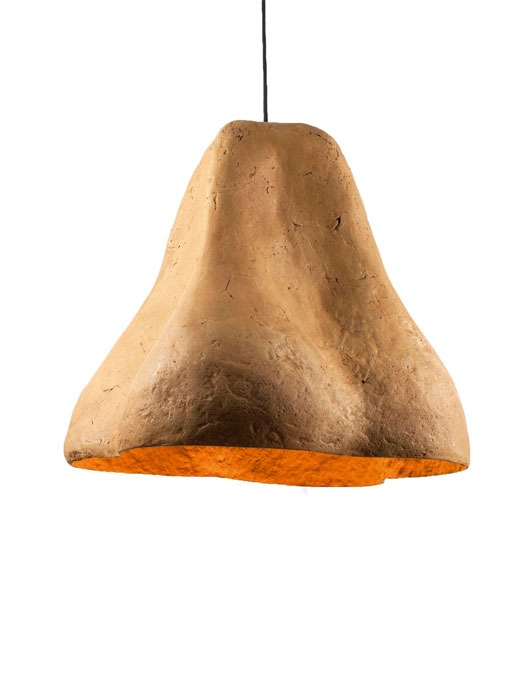
Natural Forms
Maria Fiter, Founder of Barcelona-based studio Crea-Re, talks to darc about her new collection, Sensi. Inspired by parts of the human body, the new range of lamps are eco-friendly, using paper waste to form the main body of the pendant.
The Sensi collection, created by Maria Fiter of Crea-Re Studio, is a selection of lights that are self-dubbed “ecological, aesthetic and colourful”, inspired by the organic curves and movement of the human body. Each individual lamp comes directly from part of the body.
Fiter caught up with darc Editor Sarah Cullen to discuss more of the influences of the collection and how she solely created it.
“It is not obvious which lamp comes from which shape. I don’t like obvious and easy to read things. They don’t leave a space for the imagination. My lamps have abstract shapes and I don’t reject any interpretation.
“The thing I like the most when talking with people about them is that most of them realise it is something connected with a human shape. People don’t know what it is, but they feel it. This is what I like the most, when my message gets to the observer,” she says.

Despite their natural forms, these lamps turned out to be the most complex in terms of shape for Fiter. “The most difficult was to create a large scale of the bozzetto in clay and then make a mould for it in plaster. The Sensi I lamp has a plaster mould that consists of five pieces. It is necessary to divide the mould to be able to take out the papier-mâché lamp.
All of Fiter’s lamps are made with paper waste and cellulosic glue. Combining these two materials, Fiter creates the papier-mâché, which is then painted in natural, earth pigments.
“Papier-mâché, when dry, is very solid and resistant. It is not like normal paper but much more dense and stronger,” explains Fiter. “I like to use this material because it is ecological and easy to work with.
“I can make any desired shape and colour. It provides a lot of possibilities.”
Fiter uses paper that she purchases from locals in Barcelona that work with segrgation of waste: metal, wood, electronics, and paper.
“The newspaper I get comes from the recycling centre. The best paper for papier-mâché is the simplest one, not plasticised or thin, which I would deem as bad quality paper. It has to be easy to blend with a blender that I use to make the paper powder.”
For this particular Sensi collection, Fiter used a technique that is typically used by sculptors. “First, I made a positive form in plaster, and then a negative form in clay. This allows me to repeat the shape of the lampshade many times,” she explains. “Even though the lamp has the same shape there are always some variations with the surface. So each lamp is different and unique; it is not possible to make the same piece.”

Describing the length of the process, she elaborates on how the collection was formed in a matter of months: “First, I was preparing many small buzzettos in clay. Then I chose three forms that I liked the most. After that I was preparing each form on a large scale in clay and casting it in plaster. When the plaster mould was ready, then I could prepare papier-mâché and make a lamp. Usually the process of drying takes around a week or two.
“Then, when the lamp is ready, I need to sand it and paint it. I have a special technique to paint the lamps with natural pigments that is quite laborious but it makes an amazing effect. The lamps have a few tonalities of the same pigment. The darkest ones are in the cracks and wrinkles on the lamp surface. The rest of the lamp is more bright and delicate.
“I discovered the technique I use for painting my lamps by accident – by mistake. I was painting the lamp and accidentally stained it with a different colour than I had intended to. Wanting to get rid of it, I started to wash it with water immediately. I noticed that I got rid of this bad layer of paint plus the underneath layer. To fix this, I re-painted this area but it turned out very badly. So, I washed the whole lamp and I ended up getting this amazing effect with a varied tonality on the surface of the lamp. There were some darker parts in the holes and cracks of paper as well as brighter areas.
“I loved this effect and started to implement it in many of the following lamps I created.”
To create the earthy-toned colours, Fiter buys her paint pigments from Poland. “I have one brand that produces my favourite pigments called Kremer, which I always gravitate to and bring with me to Spain,” she says.
“I love earthy colours because they are so natural and look great in
interiors, and they suit my paper lamps. However, I also love strong colours, for example dark ultramarine (Ives Klein blue) which gives life to every space.”
Due to the scale of these pendants, Fiter believes they would be best suited to larger spaces in order to fully appreciate their visually strong presence. “It is like a statement lamp, it brings attention to the viewer. I see this lamp in some high and large spaces. It looks very good above the dining table in the centre of the room, or in a wide hall entrance.

“This collection is more elaborated in terms of form and it is more sculpturesque,” she comments on how this collection differs to other pieces from her studio. “Each side of the lamp is different so you can admire it from many points of view and change its position. In this way the same lamp looks different and is more interesting. Working with light is making our lives brighter.”







